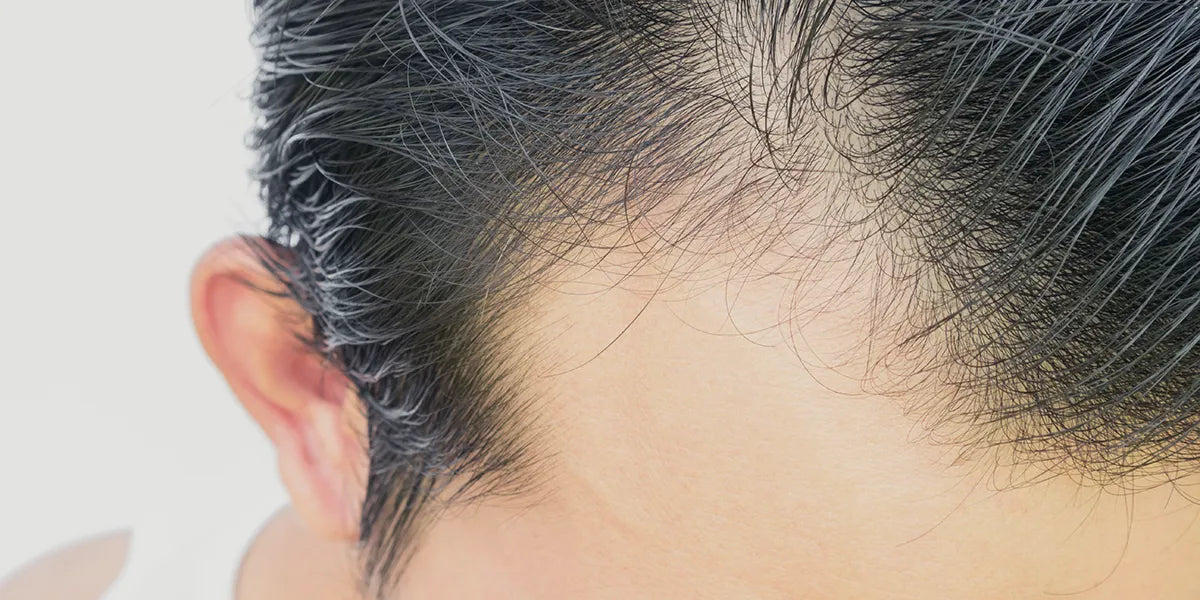When it comes to the best medication for hair loss, there is no one-size-fits-all solution. But we do know that minoxidil, finasteride and dutasteride are some of the more recognizable and commonly prescribed pharmaceutical treatments for progressive hair loss in men and women.
These agents work differently to stimulate hair growth and help restore your hair. Below, you’ll find an overview of the best medications for hair loss, whether they're approved by the FDA (Food and Drug Administration), how they were developed and work and key safety information. The final decision on which treatment to use will need to made with the help of your doctor or a hair loss specialist.
Is minoxidil the best medication for hair loss?
Minoxidil is the most widely recognized topical medication for hair loss. Minoxidil is the generic form of Rogaine™, an over-the-counter (OTC) drug that can be purchased at many retailers without a prescription.
Minoxidil drug development
Minoxidil was initially developed to treat high blood pressure. In clinical trials, improvements in hair count, density and volume were noted as a side effect of oral therapy (Badri et al. 2021). This observation spurred the development of a topical formulation for hair loss specifically. This modified dosage was largely intended to reduce the side effect profile of the drug and localize its effect within the scalp.
Minoxidil method of action
This medication’s exact mechanism of action is not entirely agreed upon, but there appear to be several ways in which minoxidil promotes hair growth.
Topical minoxidil has been associated with accelerated hair growth and improved circulation within the scalp. Countless clinical trials have demonstrated that this drug can shift hair into the anagen phase of the growth cycle prematurely and extend the period of active growth (Gupta et al. 2021). Naturally, this shortens the telogen phase (when hair lies dormant and growth stagnates) as well as the exogen phase (when hair begins to shed). Prolonging active hair growth yields more mature terminal hairs, which are typically more pigmented and lend themselves to a fuller-looking head of hair.
The direct effects of minoxidil on scalp DHT (dihydrotestosterone) have been studied in a very limited capacity, but any conclusions are largely speculative. A very small body of data suggests that minoxidil may inhibit the function of androgen receptors within the scalp. The research does not support that minoxidil has an effect on DHT, however (Hsu et al., 2014).
Legal status of minoxidil
While this drug could only be obtained by prescription until 1996, topical treatments containing minoxidil can now be purchased over-the-counter (OTC) at many retailers throughout Canada, the United States and Europe.
Minoxidil is currently the only topical medication approved by the FDA to treat androgenetic hair loss and is available in various concentrations.
Oral minoxidil is not endorsed as a treatment for androgenetic alopecia.
A topical solution containing minoxidil at 2% was first approved to treat male pattern hair loss by the FDA in 1988; the same formulation was endorsed as a treatment for female pattern hair loss in 1992. Since then, a higher 5% concentration has been added to the roster of approved topical minoxidil formulations, and selection of foam and spray options have become available (Gupta et al. 2014).
Minoxidil side effects
The likelihood of experiencing side effects varies by formulation and from person to person. Foams and topical formulations containing a lower concentration of minoxidil are less likely to cause an adverse skin reaction.
Skin irritation is the most commonly reported side effect of minoxidil. Developing a rash, redness, scaling, dryness or itching is not uncommon.
More serious side effects of minoxidil include dizziness or lightheadedness, water retention and a sudden drop in blood pressure. These symptoms can indicate that the medication has entered the bloodstream and is being circulated throughout the body.
Thinning of the scalp skin has been noted as a side effect of prolonged treatment with minoxidil. Premature aging of the skin has also been suggested as a potential long-term effect of the drug. Both of these long-term effects may be tied to minoxidil’s impact on an enzyme called lysyl hydroxylase. This particular enzyme plays an important role in collagen synthesis, which is critical to skin health.
Is finasteride the best medication for hair loss?
Finasteride is the most effective pharmaceutical drug approved by the FDA to treat androgenetic hair loss.
Finasteride belongs to a class of drugs known as 5-alpha reductase inhibitors (5-ARIs) that target a root cause of hair loss in men: DHT. These drugs interfere with the synthesis of dihydrotestosterone (DHT) and aim to reduce the concentration of this hormone within the scalp.
Finasteride drug development
Finasteride was originally as an oral medication for benign prostatic hyperplasia (BPH), a medical condition that causes prostate enlargement. Hair growth was noted as a side effect in men undergoing treatment for BPH. A lower dosage of oral finasteride was developed to treat hair loss in men shortly thereafter.
A study conducted in 2009 demonstrated that topical finasteride formulations can produce results identical to an oral regimen (Hajheydari et al. 2009). These findings reflect a larger body of clinical data, which also supports that topical finasteride has less of an impact on serum testosterone and fewer side effects than oral finasteride.
Finasteride method of action
Finasteride and other 5-ARIs target an enzyme called 5-alpha reductase (5-AR), which breaks testosterone down into DHT. Elevated scalp DHT can cause premature hair loss, follicle shrinkage (called miniaturization) and left untreated, irreversible follicle death. Individuals with a genetic predisposition are typically more sensitive to even slight fluctuations in scalp levels of this hormone.
5-ARIs are competitive enzyme inhibitors. Finasteride and other drugs in this family attach to the 5-alpha reductase enzyme and prevent it from binding to testosterone.
This effectively reduces the amount of DHT being produced by the body. It lowers concentrations of DHT at the scalp to significantly reduce the attack on hair follicles and allows hair to experience greater growth.
The 5-AR enzyme has multiple structural variants, or isoenzymes. Finasteride inhibits type II only.
Finasteride legal status
Finasteride was first approved by the FDA as a prescription medication for BPH in 1992. In 1998, this drug was indicated in the treatment of pattern hair loss at a 1 mg/day oral dosage. At present, this is the sole dosage and form of finasteride endorsed by the FDA as a treatment for hair loss.
Topical finasteride is not approved by the FDA, in any concentration.
Any topical formulation containing finasteride is considered a compounded medicine. These custom drug formulations can only be obtained from select pharmacies.
Most topical finasteride formulations contain between 0.1-1% finasteride. Many are not are able to reduce the rate of penetration into the skin, but the data supports that select timed-release formulations can be compounded at up to 2.5% finasteride.
Finasteride side effects
Most individuals can use finasteride without experiencing any serious or long-term side effects. But as with any pharmaceutical drug, there is a chance that some will develop an adverse reaction to finasteride.
The following sexual side effects are most commonly associated with finasteride and other 5-ARIs:
- Erectile dysfunction
- Decreased sperm counts
- Lowered libido
- Difficulty experiencing an orgasm
Side effects are more likely to result from oral finasteride than topical, as circulation throughout the body is inevitable and drug action is generalized. Clinical and pharmacokinetic (PK) studies suggest that a lower proportion of the drug may be absorbed into the bloodstream via the skin, minimizing the impact on DHT throughout the body.
Is dutasteride the best medication for hair loss?
Formulations containing dutasteride are novel, yet promising. The drug has been used for around 20 years to treat prostate enlargement and is sometimes prescribed off-label to treat hair loss.
Dutasteride drug development
Dutasteride is another medication that was initially used to treat BPH in biological men and was incidentally found to generate hair growth. The positive impact on hair quality and quantity sparked interest in the use of this drug to treat hair loss caused by increased DHT levels at the scalp.
Dutasteride method of action
Like finasteride, this medication is a 5-alpha reductase inhibitor. It prevents the synthesis of DHT and lowers concentrations of this androgen at the scalp, targeting hair loss at the site. Dutasteride is considered the most effective medicine in its drug class, targeting both 5-AR types I & II.
A recent literature review determined that in most clinical studies to date, an oral dosage successfully reduced scalp and serum DHT levels in men with hair loss (Zhou et al. 2019). Research suggests that dutasteride is more effective at generating hair growth and decreasing the number of fine vellus hairs on the scalp even more effectively than oral finasteride (Shanshanwal and Dhurat, 2017).
Dutasteride legal status
At present, oral and topical dutasteride are not indicated in the treatment of hair loss.The FDA-approved dosage for BPH is 1 mg/day.
Therapeutic use of this medication for male pattern hair loss is currently in the investigative stages. Most clinical studies have set out to determine the safety and efficacy of dutasteride for pattern hair loss at a dosage of 0.5mg taken orally.
Dutasteride side effects
Potential adverse effects of dutasteride use are still under investigation, though sexual side effects similar to those associated with finasteride have been noted.
There is speculation that the potential risk of side effects is greater with dutasteride than its close relative, finasteride. Dutasteride's two-pronged attack against the 5-AR amplifies the drug's therapeutic effect but may also increase the incidence of adverse drug reactions; this is especially true when it has gone systemic.
Best medication for hair loss: Takeaway
Finasteride, minoxidil and dutasteride are pharmaceutical drugs. The varying side effect profiles, methods of actions and effectiveness of each drug should be taken into consideration by the prescribing physician.
There’s no one-size-fits-all when it comes to medical treatments targeting androgenetic hair loss. The suitability of each drug should be evaluated by a physician, on a case-by-case basis before making a prescription.




